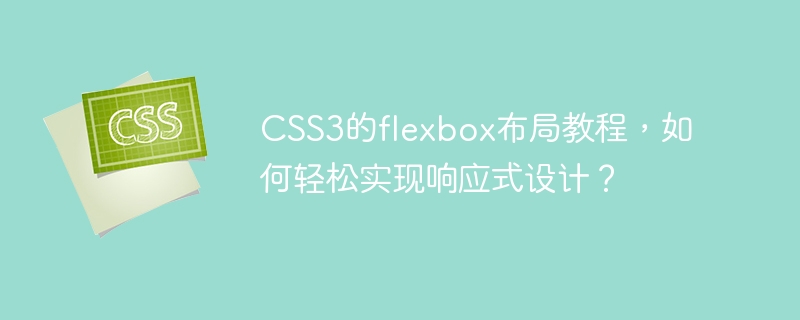

CSS3 flexbox layout tutorial, how to easily implement responsive design?
Introduction:
In the rapid development of today's network technology, responsive design has become a very important concept. With the wide application of different devices and screen sizes, how to make web pages have good display effects whether on mobile phones, tablets or computers is a problem faced by every front-end developer. The flexbox layout introduced by CSS3 provides us with a flexible and concise solution. This article will introduce in detail how to use flexbox layout and how to use it to achieve responsive design.
1. What is flexbox layout?
Flexbox layout is a brand new layout method in CSS3, which is based on the concept of "flexible box". By setting the container and the elements within the container, we can easily achieve common layout effects such as multi-column, equal-height layout, and vertical centering.
2. Basic syntax of flexbox layout
Before using flexbox layout, we first need to understand some basic concepts and key attributes:
Commonly used attributes:
The above are only some of the properties in flexbox layout. For more advanced properties and usage tips, please refer to the relevant documents.
3. Example Demonstration
The following uses an example to introduce the use of flexbox layout in detail.
HTML structure:
<div class="container"> <div class="item">Item 1</div> <div class="item">Item 2</div> <div class="item">Item 3</div> </div>
CSS style:
.container {
display: flex;
flex-direction: row;
justify-content: space-between;
align-items: center;
}
.item {
flex: 1;
margin: 10px;
padding: 20px;
background-color: blue;
color: white;
}In the above code, we create a container and place three elements inside the container. By setting various flexbox layout properties, we achieve the following effects:
It should be noted that the above example is only a small part of the flexbox layout. By flexibly using different attributes and values, we can achieve richer layout effects.
4. Advantages and applicable scenarios of flexbox layout
Compared with traditional layout methods (such as float, position, etc.), flexbox layout has the following advantages:
Based on these advantages, flexbox layout is suitable for the following scenarios:
Summary:
CSS3’s flexbox layout provides us with a concise and flexible solution that can easily implement responsive design on different devices and screen sizes. By flexibly using various attributes, we can achieve common layout effects such as multi-column layout, equal height layout, and vertical centering. I hope this article will help you understand and use flexbox layout, and I also hope you can further learn and explore this powerful layout method.
The above is the detailed content of CSS3 flexbox layout tutorial, how to easily implement responsive design?. For more information, please follow other related articles on the PHP Chinese website!